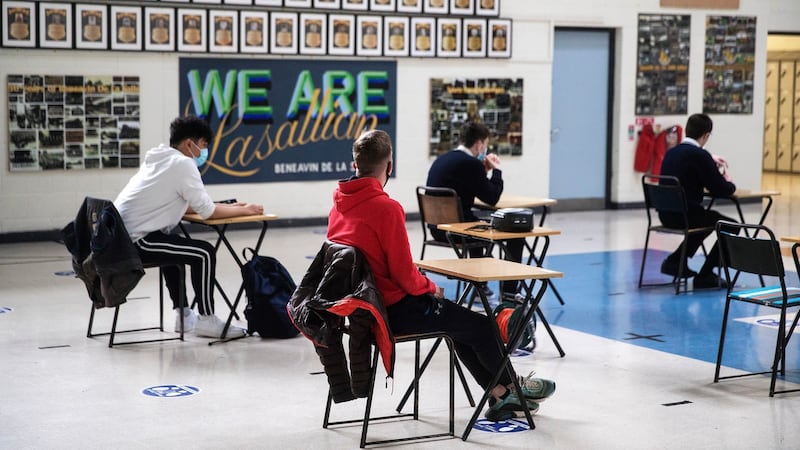Covid-19 has transformed education in Ireland. Things that were once deemed too expensive or impractical became possible overnight: class sizes fell to reduce overcrowding and limit the spread of the virus, alternatives to the Leaving Cert were introduced as emergency measures, teachers assessed their own students, online learning took off, more teachers were employed to cover staff absences, cleaning budgets were put in place and more money was made available to schools and third-level institutions.
Against this changed landscape, the first in-person teacher union conferences for three years are being held this week: the Irish National Teachers' Organisation (INTO), which represents primary teachers across the island of Ireland, meet in Killarney; the Association of Secondary Teachers (ASTI), which represents post-primary teachers, meets in Cork; and the Teachers' Union of Ireland (TUI), which represents post-primary teachers as well as lecturers in the further and higher education, meets in Wexford.
Among teachers, there is a strong feeling the gains made over the course of the pandemic should not be unwound.
"It took a pandemic for resources that we had spent decades fighting for to be put in place," says John Boyle, general secretary of the INTO. "We don't want to go back."
The Irish Times spoke to dozens of teachers, school principals and union leaders and asked two questions. How has Covid changed education – and what should happen next?
Class sizes
The Minister for Education Norma Foley has reduced class sizes for two years in a row, but average class sizes in Ireland are relatively large compared to other countries.
A wealth of evidence shows a correlation between larger classes and mean performance in reading.

“We want a post-pandemic recovery plan with a reduction in class sizes as a central tenet,” says Boyle. “The cost won’t be huge because the teachers are already in place and primary enrolments have peaked – all the Minister has to do is keep the existing teachers”
ASTI member Conor Murphy, an English teacher at Skibbereen Community College, says the reduction in class sizes at his school made it much easier for him to teach and for students to learn, while the issue was raised as a priority by four other teachers we spoke to.
Investment
Boyle says that Covid led to investment in school cleaning and ventilation, and it should be retained to keep schools as free as possible of Covid, flus, colds and other viruses.
“The idea that would now disappear is panicking us,” says one teacher.
School closures during Covid also saw a pivot to remote learning, and Boyle says this highlighted the lack of adequate information and computer technology and the need for increased investment.
"We negotiated additional hours for the most vulnerable who were most affected by school closures," Boyle says. "But the Covid Learning and Support Scheme (CLASS) has not been able to get enough teachers to cover those hours, and many remain unused."
The pandemic did see an additional 680 teachers employed as substitutes, and all the unions want to keep this supply panel. But Boyle says that not all parts of the country are covered by this scheme.
Middle management
In the austerity years, massive cuts were made to middle management in schools, dramatically increasing the workload of principals.
Teachers say that, despite some restoration of these posts in 2017, much more remains to be done.

“There was a high level of attrition for principals and deputies,” says Boyle. “[Because of the cuts], we found that people applying for these vacated roles didn’t have leadership experience, and this is destabilising and demoralising.”
Maeve Tierney, principal of St Cronan's Primary School in Bray, says they had 13 assistant principals in 2009 and, today, have a fifth of that number.
“The chief inspector identifies it as an issue,” she says. “I’ve seen our posts disappear one by one and, for schools, it means they can’t always take on the initiatives they want to. Principals including me work Sundays in preparation for Monday. I would love to have someone to support us with summer building works, a bursar and teachers paid to take on all the extracurricular work of a school instead of schools having to rely on their goodwill.”
Pay and conditions
ASTI president Eamon Dennehy says that teacher pay will dominate the first day of their convention, with motions calling for equal pay for all teachers irrespective of when they entered the profession and pay increases to address cost-of-living issues.
At the TUI, longer-serving members have diverted a planned 1 per cent pay increase to their younger colleagues to help narrow the pay gap.
"It is an act of solidarity among teachers, and we are putting our money where our mouth is," says TUI president Martin Marjoram. "But we need more urgency from the Department of Public Expenditure and Reform. "
Boyle says the current pay agreement is not fit for purpose.
“Teachers can’t afford weekly shopping at a time when the Irish economy is holding up strongly. Teachers were on the frontline during the pandemic but all they got was a deal that was not in line with inflation.”
On the Government’s side, however, Ministers fear that pay rises for teachers will only exacerbate inflation.
Senior cycle reform
Major changes have been announced to the Leaving Cert in recent months, with an increased emphasis on continuous assessment and exams being spread across two years, rather than all being held at the end of sixth year. The aim is to reduce stress and pressure for students but will it work?
Teachers are cautious and many of those who spoke to us are pointing fingers at the CAO college entry system, which is controlled by the third-level institutions themselves.

Recently, TUI general secretary Michael Gillespie told the Oireachtas Joint Committee on Education that the CAO was the primary source of stress for students.
“We would like to see the Leaving Cert focused on what it should be: not a mere entry route to third-level but instead [a chance] for students to demonstrate their range of abilities and achievements.”
Teacher and education columnist Jennifer Horgan says that "it isn't the teacher's duty to carry out a task required by the CAO to funnel students into university".
Adrian Hendrick, a career guidance teacher at Lusk Community College, says that the higher education institutions should bring in reforms to the CAO, suggesting that third-levels might also consider personal statements, as happens in the UK. Such a move would need to be carefully approached, however, with some evidence from the UK that this can further advantage the most privileged students.
Murphy, meanwhile, says that Covid highlighted the inequities between students who had their own dedicated study space, use of computers and technology and good-quality broadband and those who didn’t.
"So while continuous assessment sounds great, it could mean some students doing this work around a crowded kitchen table while others have a nice, quiet place to study. It's also worth bearing in mind that Junior Cycle students hate classroom-based assessments, finding them stressful and time-consuming: now, imagine those assessments are tied to your CAO points."
Student grading
During the pandemic, teachers agreed to assess their own students as part of the accredited and calculated grade systems, but the consensus among educators is that this would not work as an ongoing grading mechanism.
“There was a lot of pressure on teachers [who had to mark their own students] during the last two years,” says Marjoram.
“Teachers engaged with integrity, but there are still communities where they are shunned because of the grades that they awarded. It also changed how students and teachers relate to each other: instead of teachers helping and advocating for their students, students saw [their interactions] with teachers as feeding into their assessment.
“It is desperately difficult to have a standardised system when individual teachers determine grades, and it’s not complex for additional components to be externally assessed: indeed, they already are in 27 of 41 Leaving Cert subjects.”

















